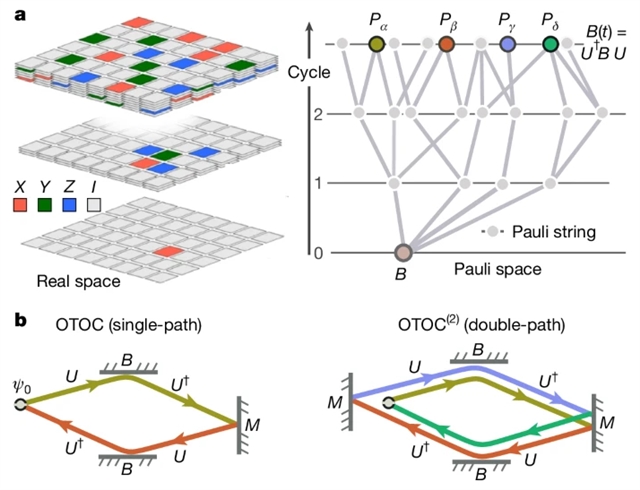
近日,美国谷歌量子AI团队研究了量子遍历性边缘处相长干涉的观测。2025年10月22日出版的《自然》杂志发表了这项成果。
量子多体系统的动力学特征由时空分离点的关联函数重构而来的量子观测值来表征。然而,在具有快速纠缠产生的动力学中,由于信息加扰的影响,量子观测值通常在很长一段时间后对底层动力学细节失敏。为了突破该限制,并能够获取实验系统中的相关动力学信息,人们已成功实现了重复时间反演方案。
研究组实验性地测量了超导量子处理器上的二阶超时序关联函数(OTOC(2)),并发现其在长时间尺度上对底层动力学仍保持敏感。此外,OTOC(2)在高度纠缠的量子多体系统中表现出量子关联性,若无时间反演技术则无法获取。通过在量子演化过程中插入泡利算子,进而相位随机化海森堡图景中泡利字符串的实验方案证明了这一点。
OTOC(2)的测量值在该方案作用下发生了实质性的变化,从而揭示了在构型空间中形成了大环路的泡利字符串之间的相长干涉。观测到的干涉机制也赋予了OTOC(2)高度的经典仿真复杂性。这些结果,结合OTOC(2)在解析量子动力学有用细节方面的能力(如通过哈密顿学习的例子所示),表明了实现实际量子优势的可行途径。
附:英文原文
Title: Observation of constructive interference at the edge of quantum ergodicity
Author: Hartmut Neven.
Issue&Volume: 2025-10-22
Abstract: The dynamics of quantum many-body systems is characterized by quantum observables that are reconstructed from correlation functions at separate points in space and time1,2,3. In dynamics with fast entanglement generation, however, quantum observables generally become insensitive to the details of the underlying dynamics at long times due to the effects of scrambling. To circumvent this limitation and enable access to relevant dynamics in experimental systems, repeated time-reversal protocols have been successfully implemented4. Here we experimentally measure the second-order out-of-time-order correlators (OTOC(2))5,6,7,8,9,10,11,12,13,14,15,16,17,18 on a superconducting quantum processor and find that they remain sensitive to the underlying dynamics at long timescales. Furthermore, OTOC(2) manifests quantum correlations in a highly entangled quantum many-body system that are inaccessible without time-reversal techniques. This is demonstrated through an experimental protocol that randomizes the phases of Pauli strings in the Heisenberg picture by inserting Pauli operators during quantum evolution. The measured values of OTOC(2) are substantially changed by the protocol, thereby revealing constructive interference between Pauli strings that form large loops in the configuration space. The observed interference mechanism also endows OTOC(2) with high degrees of classical simulation complexity. These results, combined with the capability of OTOC(2) in unravelling useful details of quantum dynamics, as shown through an example of Hamiltonian learning, indicate a viable path to practical quantum advantage.
DOI: 10.1038/s41586-025-09526-6
Source: https://www.nature.com/articles/s41586-025-09526-6
Nature:《自然》,创刊于1869年。隶属于施普林格·自然出版集团,最新IF:69.504
官方网址:http://www.nature.com/
投稿链接:http://www.nature.com/authors/submit_manuscript.html
